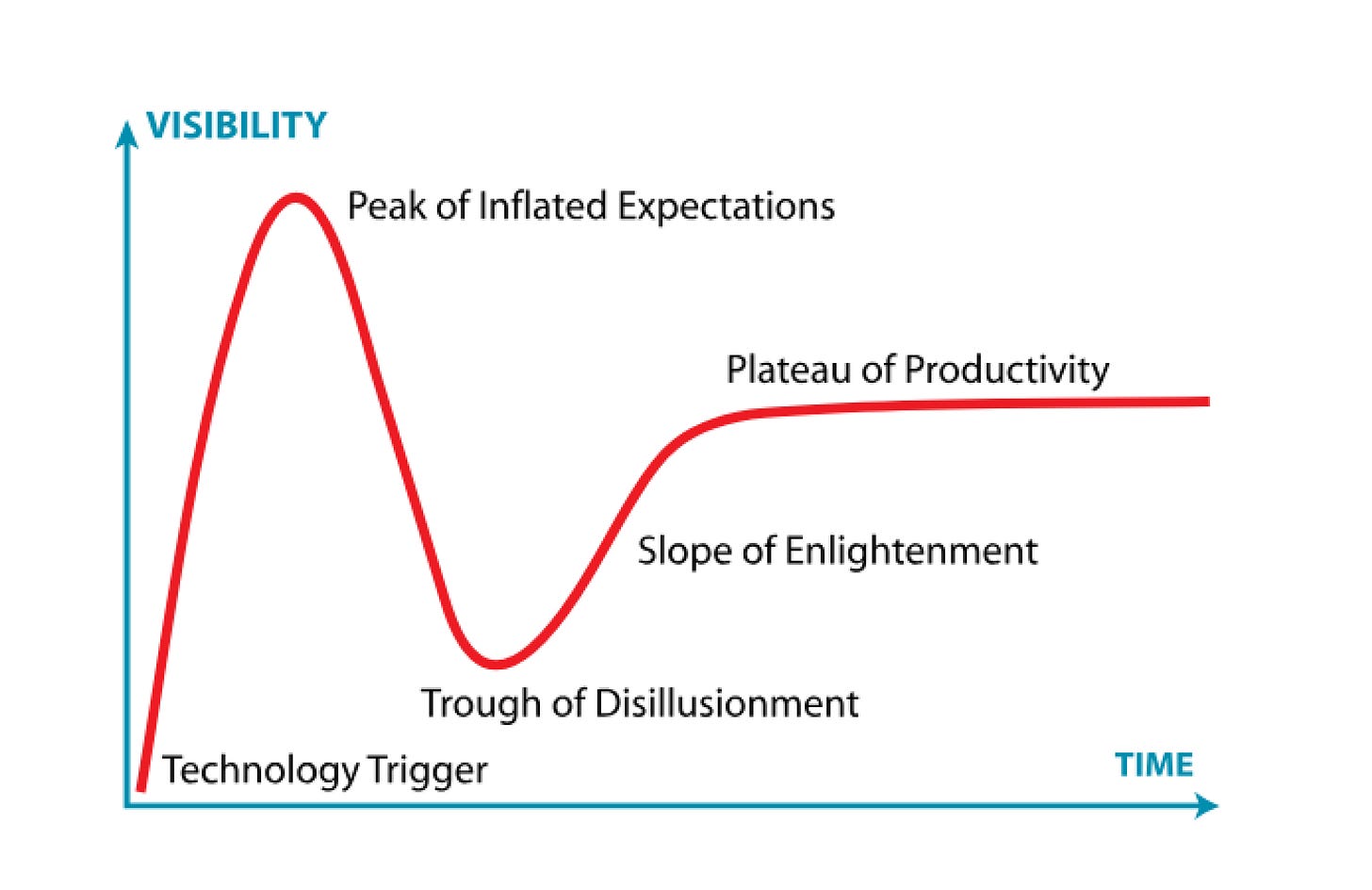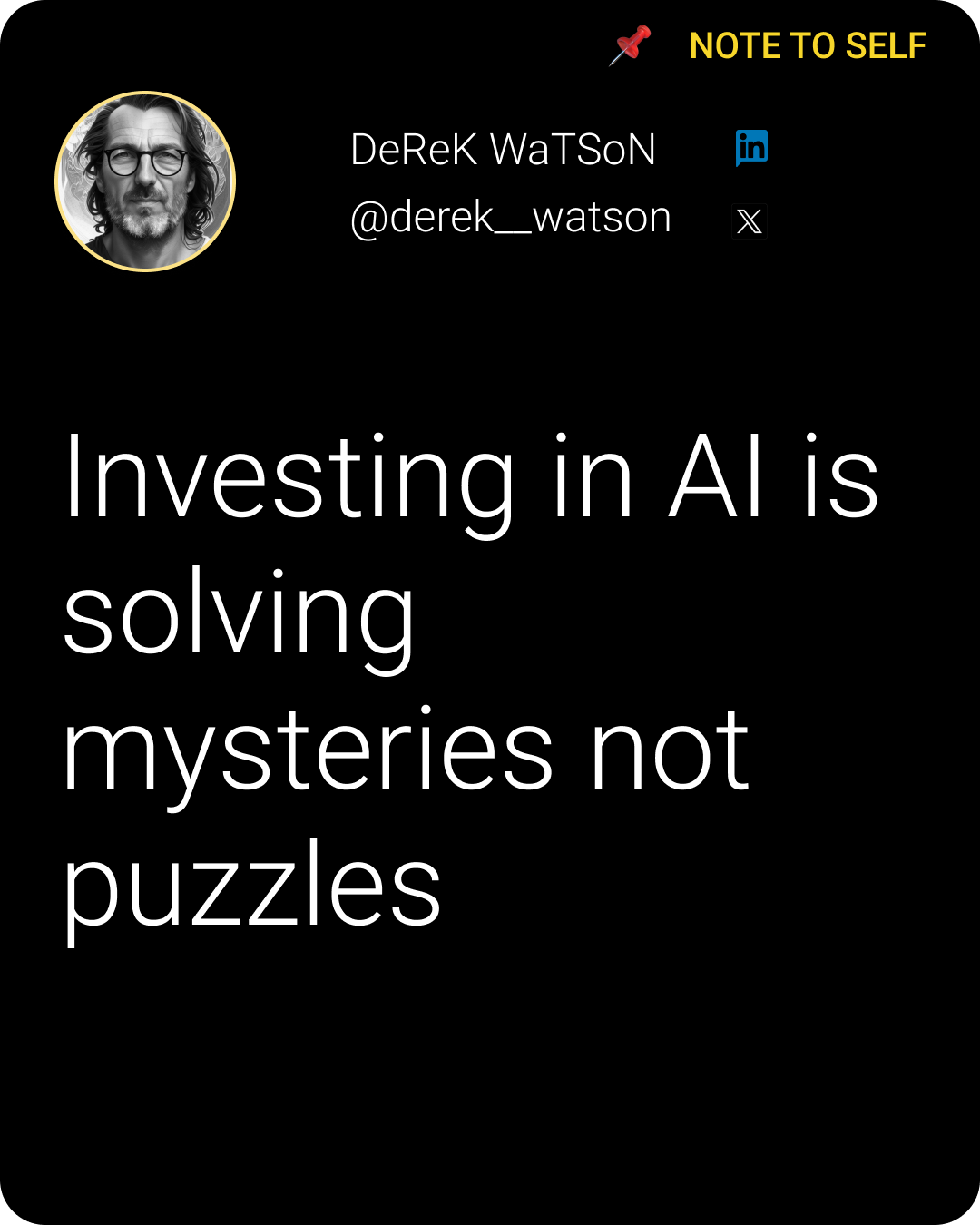Here’s your Monday dose of The F42 Brief.
📈 Trending Now
The one thing that’s making all the noise …. with a bit of fact checking.
💡Innovator Spotlight
Founders that are doing stuff differently.
🛠️ Tool of the Week
Something useful to up your startups velocity.
📌 Note to Self
Stuff I constantly remind myself about, don’t want make the same mistakes again.
📈 Trending Now
The Reality Behind AI Hype
• 🔍 A recent S&P Global survey reveals that 42 per cent of organisations have ditched most of their generative-AI initiatives this year—up from just 17 per cent a year ago. You might have noticed the headlines: what began as an all-guns-blazing rush has very quickly turned into a case of “where’s the ROI?” This jump highlights how initial excitement can evaporate once projects fail to deliver the goods—exactly the kind of trough you see in most innovation cycles.
• 🔄 It’s worth remembering that every major technology goes through hype, disappointment, and then steady adoption. In fact, Gartner’s famous Hype Cycle shows that this trough of disillusionment is par for the course; we saw the same pattern with the internet, mobile computing and cloud before they became business-critical tools.
• ⚙️ So, why the sudden U-turn? Well, for starters, a lot of valuable data remains locked away in legacy systems or scattered across different silos, making it tricky to feed clean, reliable inputs into AI models. On top of that, there’s a genuine shortage of people who both understand the nuts and bolts of AI and know how to embed it into existing workflows. And let’s be honest: boards aren’t keen to gamble with their reputation. If an AI bot mishandles sensitive customer data or pushes out dubious recommendations, the brand fallout could be severe. In short, moving from a flashy prototype to a robust, production-ready solution has proven far harder—and riskier—than many anticipated.
• 💨 Then there’s the infamous “pump cycle” driven by the hyperscale cloud providers. Companies such as Microsoft, Amazon and Google routinely hand out hefty compute credits to early-stage AI startups. Sounds generous, right? But here’s the catch: those credits often mask the true cost of running GPU-hungry workloads. Startups ramp up their experiments on borrowed capacity, only to hit a brick wall once the freebies vanish or the actual costs come home to roost. Meanwhile, cloud providers get to boast about inflated usage metrics during that honeymoon period, which in turn attracts more investment and justifies further promotional outlays. The end result? A self-perpetuating loop: free credits fuel over-enthusiastic usage figures, which draw in investors, but ultimately lead to dashed expectations when the subsidies disappear.
• 🎯 For founders and investors alike, the lesson is to focus on sustainable, cost-effective pilots instead of chasing inflated usage stats. Have a proper look at your data pipelines, pinpoint a high-value, low-risk use case—perhaps automating a mundane customer-service task—and assemble a lean team to tackle integration and compliance from day one. By recognising the limitations of cloudy credit incentives and addressing the practical hurdles head-on, you’ll be far better placed to climb out of this “trough of disillusionment” and seize AI’s genuine potential.
💸 New Funds looking to give you cash
Look out for the The Raise Report this Wednesday, bring you all the new funds that have raised capital and looking to deploy.
Master the Art and Science of Fundraising
Unlock the inner workings of capital raising with proven insights from those who've raised millions. Gain real-world strategies that transform ideas into funded ventures.
Day One Tue, 3 Jun 9:00 AM PST
Live looper performance
Vision & kickoff with Kurt, Derek & Henrik
Raise perspectives: Family office, VC, CVC & PE
Capital stack & round sequencing
VC terms & cap-table workshop
Day Two Wed, 4 Jun 9:00 AM PST
Live artist performance
Non-dilutive & sponsored capital
Community wild-card panel
GTM strategies that secured funding
Fused & Funded evening networking
Day Three – Thu, 5 Jun 9:30 AM PST (IRL @ VentureHaus, Las Vegas)
9:30 AM Arrival, coffee & open networking
10:00 AM Fireside Feature – $3K → $5K Scaling Pathways with Phil Peredo
12:00 PM Networking lunch – small tables with Channel Champs & investors
1:00 PM Workshop – Money Mindset Mastery with Shane Scott (Shark Tank coach)
2:00 PM Founder pitch sessions – live & virtual investors, moderated
3:30 PM Round-robin 1-on-1s – founders rotate through 2-3 strategic meetings; investor breakouts
5:00 PM Closing toast & call-to-action – Fusion42 Accelerator + Fusion42 Fast invites, photo ops, final networking
💡Innovator Spotlight
Why It Feels Like the VHS vs. Betamax of AI Agents
I’ve been watching the AI world recently, and it really feels like the VHS-Betamax era all over again—only now it’s agent protocols being bandied about instead of videotape formats. If you’re a founder, framer or funder, it’s worth knowing which side of history you’re on before the standards begin to solidify. Here are the three main protocols making waves in 2025:
1. Model Context Protocol (MCP)
I see MCP everywhere right now, especially in single-agent setups that need direct tool access and richer context. Think of it as the bridge between an AI model and any external data source or function—it’s why you can have an AI assistant that not only talks back but also fetches real-time KPIs from your databases. Big players like Microsoft (Azure AI Foundry, Copilot Studio) and GitHub are backing MCP, and there’s an open ecosystem actively strengthening its security and authorisation layers. For startups building specialised AI helpers—say, a fundraising coach that pulls live investor metrics—MCP is probably your go-to.
2. Agent2Agent Protocol (A2A)
Announced by Google in April 2025, A2A is built for when you need several agents doing different things but all working in concert. Picture a lead-gen agent passing qualified contacts to a customer-onboarding bot, which in turn updates your CRM—without you manually orchestrating the handoff. Over 50 major tech firms (Salesforce, Accenture, and the like) have already joined the consortium. If you’re designing a multi-layered AI workflow—perhaps one agent handling market research, another crafting pitch decks, and a third managing outreach—A2A will be critical for ensuring they communicate seamlessly.
3. Agent Communication Protocol (ACP)
IBM’s open-source answer to agent chatter, ACP lets agents communicate directly—peer to peer—whether synchronously or asynchronously. It’s RESTful at its core, so any developer worth their salt can have two agents talking in minutes. The beauty of ACP is its community-led governance (Linux Foundation, DeepLearning.AI), which makes it relatively easy to plug in new agents or swap out existing ones without a complete rebuild. If your roadmap involves scaling up to dozens of specialised agents—each acting autonomously but still needing to share insights—ACP offers the flexibility you’ll need.
Why It Matters
Just as VHS won out over Betamax not necessarily because it was superior but because of ecosystem support, these agent protocols are competing on adoption, security, and ease of integration. As a founder, I’m keeping a close eye on which protocol my chosen platforms support—because once the market consolidates, it’ll be hard to switch horses midstream. If you’re investing in AI tools or building your own agents, pick a protocol that aligns with your long-term architecture and the partners you intend to work with. In short: know your MCP from your A2A before one of them becomes the de facto standard.
If you have not joined the Fusion42 Community on Telegram — A space for Founders, Framers, and Funders who show up to get **it done,
it is probably time to do so.
For the ❤️ of Startups
🛠️ Tools of the Week
The latest release from DeepSeek is the DeepSeek-R1-0528 model, unveiled on May 28, 2025. This update is an enhancement of their R1 reasoning model and brings significant improvements in reasoning depth, mathematical skills, and code generation capabilities.
Notable benchmark gains include:
AIME 2025 accuracy increased from 70.0 to 87.5
GPQA score improved from 71.5 to 81.0
LCB_v6 (LiveCodeBench) rose from 63.5 to 73.3
Aider benchmark jumped from 57.0 to 71.6
The upgrade also features reduced hallucination rates, enhanced support for function calling (including improved JSON output), and better performance in front-end web development, resulting in more aesthetically pleasing generated web pages and games. The model now consumes more tokens for complex reasoning tasks, reflecting its deeper analytical processes.
This release positions DeepSeek-R1-0528 just below the top-performing models like OpenAI’s o3 mini and Google’s Gemini 2.5 Pro on code generation and reasoning leaderboards, while outperforming several other notable models. The update was made available on Hugging Face and through DeepSeek’s API, though the company has not yet issued a formal public announcement.
There is also high anticipation for DeepSeek’s next-generation R2 model, but as of June 2, 2025, the most recent official release is DeepSeek-R1-0528
Key points:
The model weights are open and free to access and use for most purposes.
The source code is under the MIT license, but the model itself is under the DeepSeek license, which is not fully open source due to some use-based restrictions.
The model is widely considered open and free for general research and development, but users should review the license for any specific limitations
Hugging Face Model Page
https://huggingface.co/deepseek-ai/DeepSeek-R1-0528
GitHub Organization
https://github.com/deepseek-ai
(Includes repositories for DeepSeek-R1, DeepSeek-V3, and other models)
Official Website
https://www.deepseek.com/en
(Offers web/app access to DeepSeek-V3 and R1 models, along with API information)
📌 Note to Self
Thank you for reading. If you liked it, share it with your friends, colleagues and everyone interested in the startup Investor ecosystem.
If you've got suggestions, an article, research, your tech stack, or a job listing you want featured, just let me know! I'm keen to include it in the upcoming edition.
Please let me know what you think of it, love a feedback loop 🙏🏼
🛑 Get a different job.
Subscribe below and follow me on LinkedIn or Twitter to never miss an update.
For the ❤️ of startups
✌🏼 & 💙
Derek












Here for the innovator part! A great read brother. Question? What are some issues in the industry you think an innovator could tackle, or maybe shift eyes to a different perspective , different solution. I’m asking because l like to ponder issues at source. Always down to collab, always down to chat.
Thanks for the overview (and reminder) of the hype/disappointment/steady adoption cycle. Spot on observation.